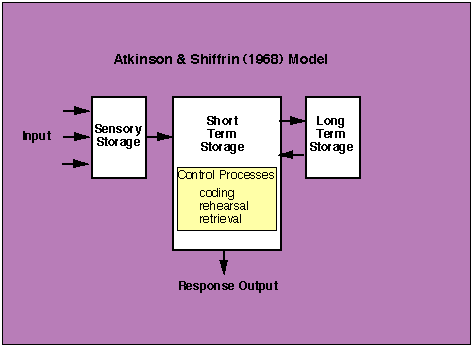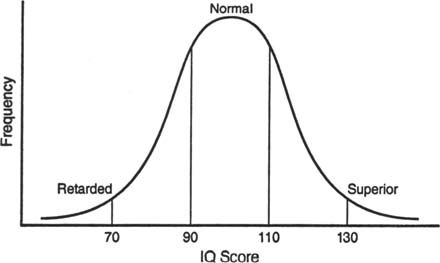MEMORY & FORGETTING
Memory can be defined as the storage of learned information for retrieval and future use.
Memory: A cognitive system that retains information. Similar to a computer's ability to retain information, your brain remembers bits of information such as your mother's name or first day of college. You would be unable to retrieve this information if you were unable to have it stored in your memory. There many components to memory including senory memory, short-term memory, long-term memory, forgetting, and more.
I. The Key Questions
When psychologists study memory they usually focus on 3 key questions:
1) How does information get INTO memory?
2) How is information MAINTAINED in memory?
3) How do we get information BACK OUT of memory?
These 3 questions correspond to the 3 key processes in memory:
ENCODING --> STORAGE --> RETRIEVAL
II. Basic Processes (we will discuss each in detail later, but for now we need a few definitions)
A. Encoding - process of forming a memory code in order to get information into memory.
For Example: we may emphasize the shape of a dog's nose to identify the breed (e.g., a German Sheppard has a longer, more pointed nose than a bull dog) and subsequently make a code for "German Sheppard" according to the dog's nose.
1) Encoding usually involves attention - focusing awareness on a narrow range of stimuli or events.
B. Storage (memory stores) - maintaining encoded information in memory over a period of time.
C. Retrieval - recovering information from memory stores.
These 3 processes are the foundation for all memory - how it works and why it may not work at times. When memory does not work, we have forgetting, which may occur at any of these 3 levels. We will address forgetting soon, but for now let's focus on how memory works.
III. The Atkinson & Shiffrin Information Processing Model
According to this model information must pass through two temporary storage buffers (stores) before it can be placed into more permanent storage, and then retrieved for later use. Take a look at the model below to get an overview of the whole process, and then move on with the notes.

For the memory process to begin, we must first encounter some stimulus (identified as "input" in the model above), which goes into sensory storage.
A. Sensory Storage - the immediate, initial recording of sensory information.
Here information is preserved for a very brief time (usually only a fraction of a second) in its original form.The name "sensory storage" implies that something perceptual occurs. In fact, what enters into sensory storage are images (in the case of vision), or more precisely, afterimages. Although the actual stimulus may have disappeared, we may still perceive it for a second or so.The actual length of time an image exists in sensory storage depends on the modality:1) Iconic memory - a visual image in sensory storage. Although most people seem to believe that visual images last longer (this is based on intuition, not science), they do not - they last approximately 1/4 of a second.2) Echoic memory - auditory image. These (as well as other senses) seem to last up to 3 seconds.
SO, we can see that within sensory storage we have 2 distinct stores - an iconic and echoic.
Once one of these types of memories occur, we have some raw data that will be lost if we do not engage in one of two processes (these two processes are required to get information from sensory memory to short term memory).
1) Pattern recognition - when new information comes into sensory storage, we actively search through long term memory in an effort to find a match for this new raw data.2) Attention - this is pretty obvious. The more we pay attention to a stimulus, the more likely it will continue onto the next memory store (short term memory)
Once we have successfully recognized or attended to the information, we are able to bring the information into SHORT-TERM MEMORY (STM).
B. Short-Term Memory - a limited capacity store that can maintain information for approximately 20 seconds.
It is possible to extend duration of STM (to approximately 30 seconds) by engaging in a process called Maintenance Rehearsal.
1) Maintenance Rehearsal - the process of repeatedly verbalizing or thinking about the information.
For example - late at night, you have been out partying all night, you et back home and you are hungry. you decide...it's time for pizza. So you pick up the phone and call information to get the number of a local pizza delivery place. When the operator gives the number, you say the number over and over so that you don't forget it in the time it takes to hang up and dial the number. This process of repeating the number over and over is actually maintenance rehearsal. It won't help get the information into long term memory, but it will help keep it in short term memory a little longer.
2) Slots - STM seems to be divided into "slots" - to be precise, STM has 7 slots, each one capable of holding one piece of information.
This is also commonly referred to as the MAGIC #7 (+/- 2), which was introduced by George Miller.
But, we are bombarded with so much information all the time that STM can become cluttered. In order to prevent the clutter from become too much, STM pushes some information out in order to make room for other information. But what gets pushed out???
3) Primacy and Recency
a) Primacy - when you are receiving information, the information perceived first is more likely to be remembered. This more recent information may simply get to long term memory more easily, and thus be remembered or we may just rehearse the early information more.b) Recency - information perceived toward the end of an event is also more likely to be remembered. So, information in the "middle" seems to get pushed out and is less likely to be remembered.
While maintenance rehearsal will help keep information in STM, the only way to bring information into long-term memory is through ELABORATIVE REHEARSAL.
4) Elaborative Rehearsal - connecting new information with previously stored, already existing associative structures.
For Example - when our sixth grade teachers used to make us put a vocabulary word into context in a sentence - this combines the new information (the vocabulary word) with an associative structure (the sentence)."Johnny, the word is pimple. Can you use pimple in a sentence?" "Yes. My head is so full of all of this Psychological information, I think it is going to pop like a big, white, pimple"
C. Long Term Memory (LTM) - an unlimited capacity store that can hold information over lengthy periods of time.
The name is a bit of a misnomer, since information in LTM may stay there over the course of a life-span.
1) there are 3 categories (or subcategories) of LTM:
a) Procedural memory - this is the most basic type of long term memory (very simplistic) and primarily involves memories of rudimentary procedures and behaviors.For example - procedural memories include our memory for eating, sitting in a chair, etc. As you can see, these are are based on behavior.some even suggest that there is an additional, basic category called DECLARATIVE memory - just factual information like names and dates.b) Semantic memory - mental models of the environment as well as procedures.For example - knowledge of word meanings, language, strategies for problem solving, factual information (like laws), etc.c) Episodic memory - information about events, people, places, etc., that include an autobiographical aspect as well as a time and place.For example - "I saw a bear last night in my back yard."
Now that we have seen how memory works, let's look at how or why memory may NOT work.
IV. Theories of Forgetting
1) Decay - forgetting due to memories fading over time. This does NOT apply to LTM.
This often occurs in sensory storage and STM since we do not need to process and store all the information that we encounter. As a result, there is a lot of information we don't attend to, recognize, or rehearse, and so it simply fades away.
2) Interference - hindrance of learning new information because of other information learned before or after the new information. There are two types:
a) Proactive interference - information learned previously causes problems with new information.For Example - if you took Psychology 101 already with a different teacher they may have presented information differently than me. This may affect your ability to recall the information in the way I have explained it. You get them mixed together.b) Retroactive interference - new information cause recall problem with previously learned information.For example - now you are learning in my class, you can not recall the information the way it was presented by your previous Psychology 101 instructor.
3) Retrieval-Based Forgetting - information stored in LTM is not being accessed or brought out properly; however, if given enough time or cues, it is possible to retrieve the information.
a) this suggests that LTM is permanent. Since the information is said to still be in LTM and not lost (the person has the information but just can't get to it).
4) Storage-Based Forgetting - information in LTM was distorted, altered, or changed so it is no longer accessible when searching for what it "used to be". The information can be retrieved, but only if you look for it in its new form.
5) Motivated Forgetting - a purposeful process of blocking or "suppressing" information.
a) FREUD referred to this as Repression - keeping distressing thoughts or feelings buried in the unconscious. (I am always amused when clinical Psychologists renounce Freud as a lunatic and then, in the same breath, talk about how meaningful and real repression is. They seem to forget who pioneered this area).BUT - can we actually intentionally forget something?Here is a quick HOMEWORK assignment - do whatever you must do to forget the number sequence 5-3-1. Try as hard as you can to forget it - do what you must, but forget the number sequence 5-3-1!!b) Today, Repressed Memories are a very hot topic, but how much can we trust repressed memories? How often are these memories actually False Memories?When a repressed memory is remembered, we say it has been Recovered. A recovered memory can be defined as the emergence of a formerly repressed memory.1. even Freud, who pioneered this area, had doubts about this:a. He was never able to confirm that childhood sexual traumas cause later adult pathology.b. Even he realized that not all recovered memories were accurate.
Thus, it is possible that some or all of these memories are actually false memories.

